MERCEDES-BENZ GLK SUV 2008 Service Manual
Manufacturer: MERCEDES-BENZ, Model Year: 2008, Model line: GLK SUV, Model: MERCEDES-BENZ GLK SUV 2008Pages: 261, PDF Size: 8.67 MB
Page 41 of 261
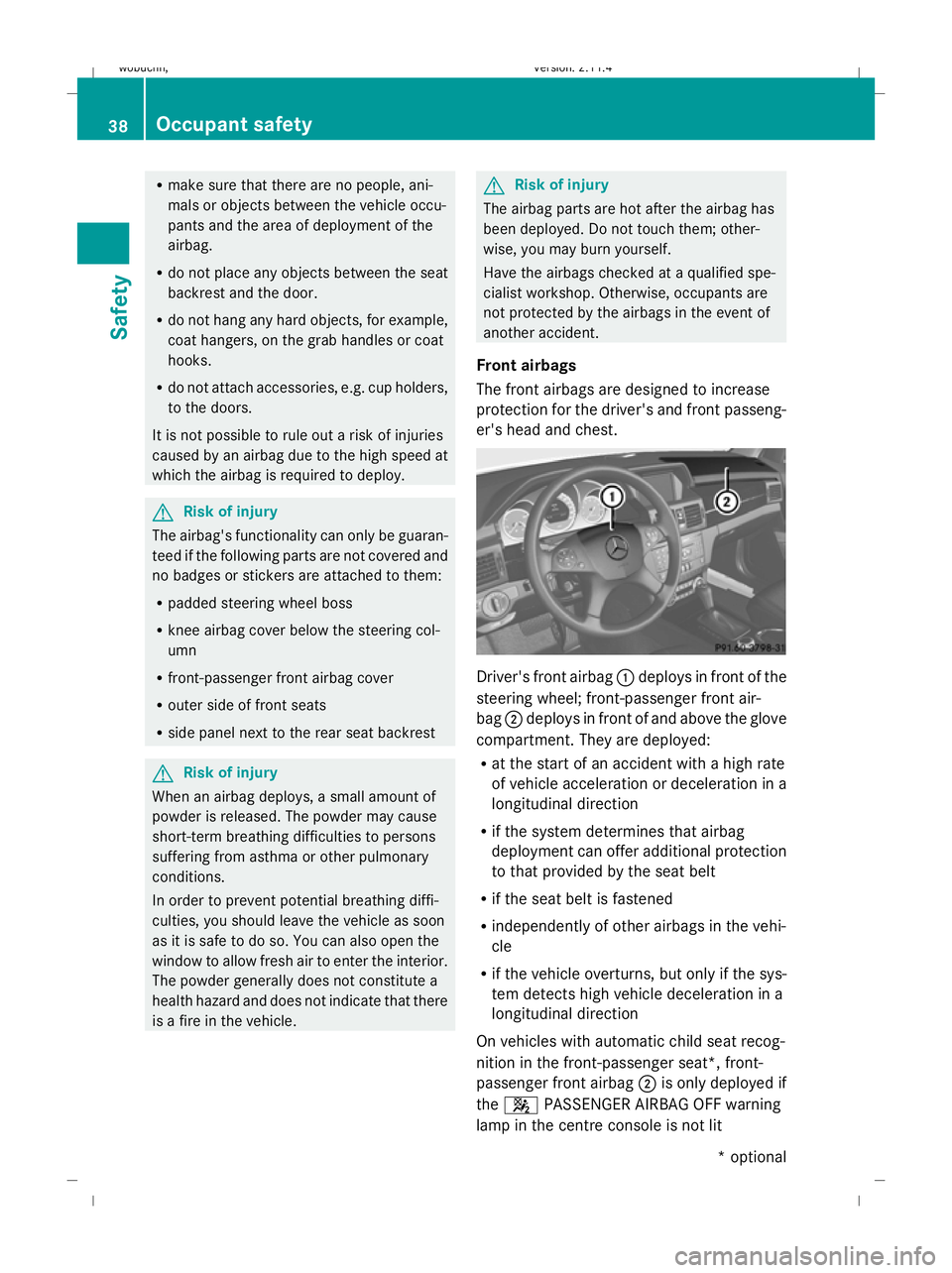
R
make sure that there are no people, ani-
mals or objects between the vehicle occu-
pants and the area of deployment of the
airbag.
R do not place any objects between the seat
backrest and the door.
R do not hang any hard objects, for example,
coat hangers, on the grab handles or coat
hooks.
R do not attach accessories, e.g. cup holders,
to the doors.
It is not possible to rule out a risk of injuries
caused by an airbag due to the high speed at
which the airbag is required to deploy. G
Risk of injury
The airbag's functionality can only be guaran-
teed if the following parts are not covered and
no badges or stickers are attached to them:
R padded steering wheel boss
R knee airbag cover below the steering col-
umn
R front-passenger front airbag cover
R outer side of front seats
R side panel next to the rear seat backrest G
Risk of injury
When an airbag deploys, a small amount of
powder is released. The powder may cause
short-term breathing difficulties to persons
suffering from asthma or other pulmonary
conditions.
In order to prevent potential breathing diffi-
culties, you should leave the vehicle as soon
as it is safe to do so. You can also open the
window to allow fresh air to enter the interior.
The powder generally does not constitute a
health hazard and does not indicate that there
is a fire in the vehicle. G
Risk of injury
The airbag parts are hot after the airbag has
been deployed. Do not touch them; other-
wise, you may burn yourself.
Have the airbags checked at a qualified spe-
cialist workshop. Otherwise, occupants are
not protected by the airbags in the event of
another accident.
Front airbags
The front airbags are designed to increase
protection for the driver's and front passeng-
er's head and chest. Driver's front airbag
:deploys in front of the
steering wheel; front-passenger front air-
bag ;deploys in front of and above the glove
compartment. They are deployed:
R at the start of an accident with a high rate
of vehicle acceleration or deceleration in a
longitudinal direction
R if the system determines that airbag
deployment can offer additional protection
to that provided by the seat belt
R if the seat belt is fastened
R independently of other airbags in the vehi-
cle
R if the vehicle overturns, but only if the sys-
tem detects high vehicle deceleration in a
longitudinal direction
On vehicles with automatic child seat recog-
nition in the front-passenger seat*, front-
passenger front airbag ;is only deployed if
the 4 PASSENGER AIRBAG OFF warning
lamp in the centre console is not lit 38 Occupant safetySafety
* optional
X204_AKB; 1; 5, en-GB
wobuchh,
Version: 2.11.4 2008-10-15T13:20:56+02:00 - Seite 38Dateiname: 6515_0671_02_buchblock.pdf; preflight
Page 42 of 261
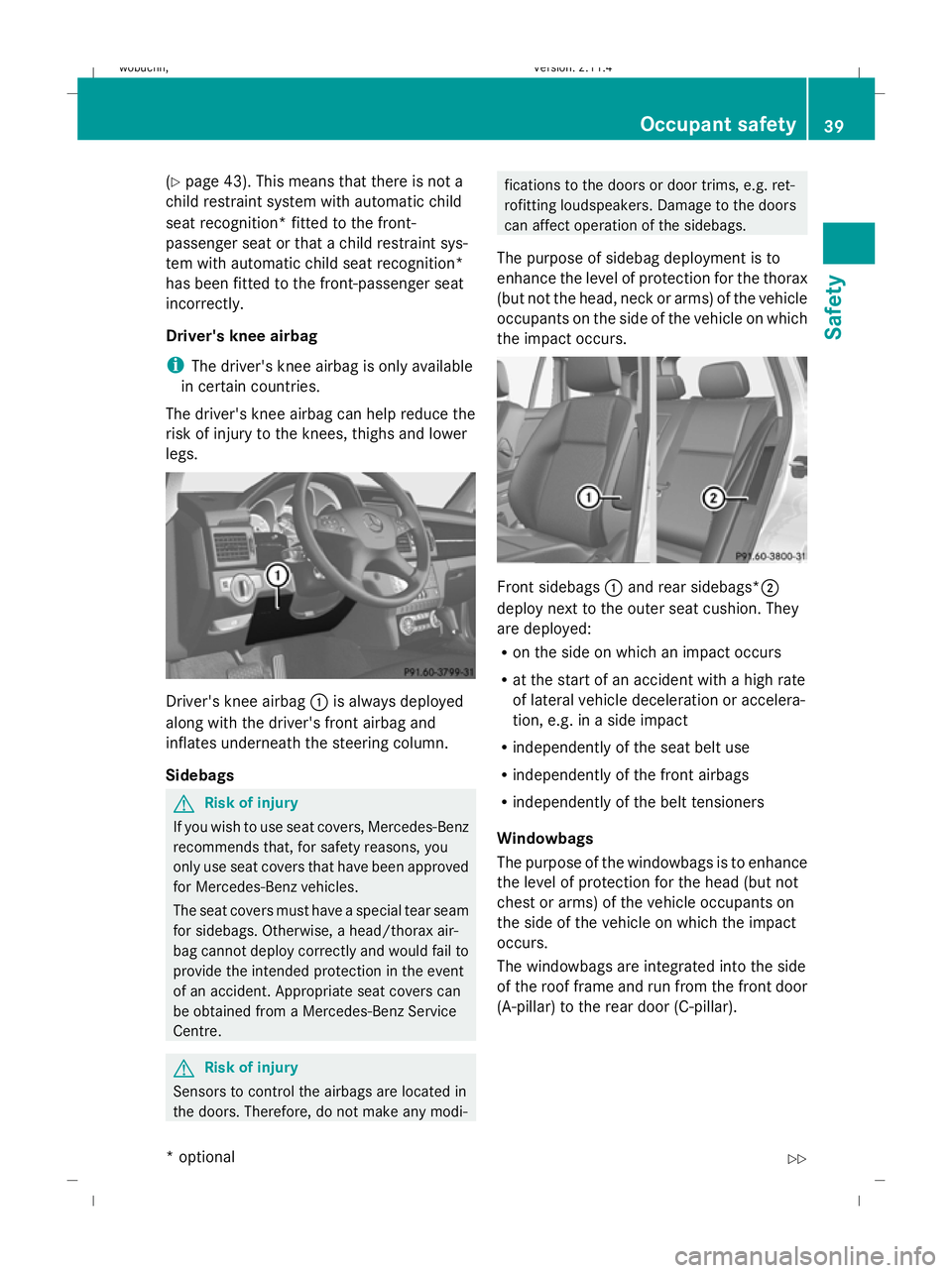
(Y
page 43). This means that there is not a
child restraint system with automatic child
seat recognition* fitted to the front-
passenger seat or that a child restraint sys-
tem with automatic child seat recognition*
has been fitted to the front-passenger seat
incorrectly.
Driver's knee airbag
i The driver's knee airbag is only available
in certain countries.
The driver's knee airbag can help reduce the
risk of injury to the knees, thighs and lower
legs. Driver's knee airbag
:is always deployed
along with the driver's front airbag and
inflates underneath the steering column.
Sidebags G
Risk of injury
If you wish to use seat covers, Mercedes-Benz
recommends that, for safety reasons, you
only use seat covers that have been approved
for Mercedes-Benz vehicles.
The seat covers must have a special tear seam
for sidebags. Otherwise, a head/thorax air-
bag cannot deploy correctly and would fail to
provide the intended protection in the event
of an accident. Appropriate seat covers can
be obtained from a Mercedes-Benz Service
Centre. G
Risk of injury
Sensors to control the airbags are located in
the doors. Therefore, do not make any modi- fications to the doors or door trims, e.g. ret-
rofitting loudspeakers. Damage to the doors
can affect operation of the sidebags.
The purpose of sidebag deployment is to
enhance the level of protection for the thorax
(but not the head, neck or arms) of the vehicle
occupants on the side of the vehicle on which
the impact occurs. Front sidebags
:and rear sidebags*;
deploy next to the outer seat cushion. They
are deployed:
R on the side on which an impact occurs
R at the start of an accident with a high rate
of lateral vehicle deceleration or accelera-
tion, e.g. in a side impact
R independently of the seat belt use
R independently of the front airbags
R independently of the belt tensioners
Windowbags
The purpose of the windowbags is to enhance
the level of protection for the head (but not
chest or arms) of the vehicle occupants on
the side of the vehicle on which the impact
occurs.
The windowbags are integrated into the side
of the roof frame and run from the front door
(A-pillar) to the rear door (C-pillar). Occupant safety
39Safety
* optional
X204_AKB; 1; 5, en-GB
wobuchh, Version: 2.11.4
2008-10-15T13:20:56+02:00 - Seite 39 ZDateiname: 6515_0671_02_buchblock.pdf; preflight
Page 43 of 261
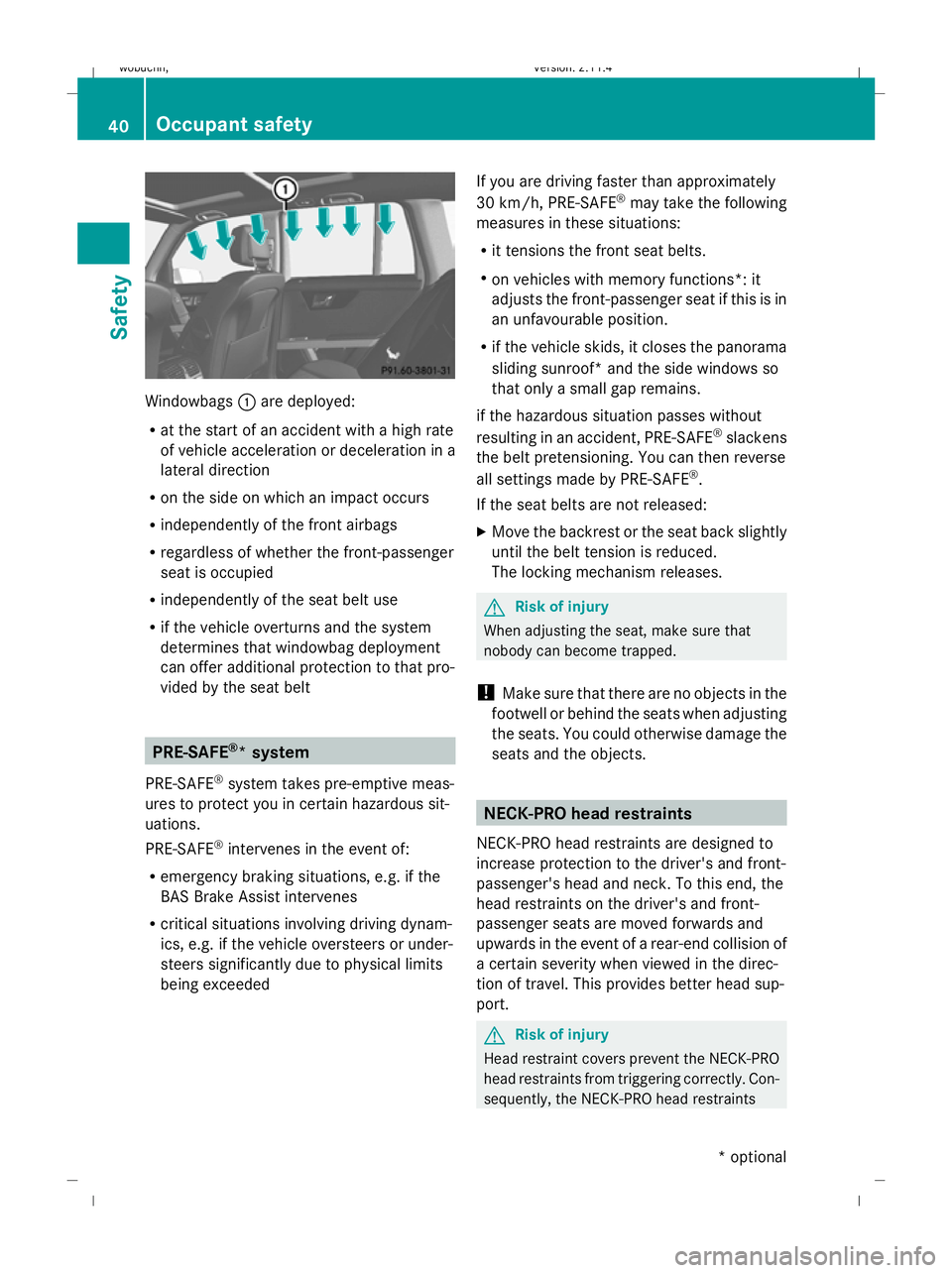
Windowbags
:are deployed:
R at the start of an accident with a high rate
of vehicle acceleration or deceleration in a
lateral direction
R on the side on which an impact occurs
R independently of the front airbags
R regardless of whether the front-passenger
seat is occupied
R independently of the seat belt use
R if the vehicle overturns and the system
determines that windowbag deployment
can offer additional protection to that pro-
vided by the seat belt PRE-SAFE
®
* system
PRE-SAFE ®
system takes pre-emptive meas-
ures to protect you in certain hazardous sit-
uations.
PRE-SAFE ®
intervenes in the event of:
R emergency braking situations, e.g. if the
BAS Brake Assist intervenes
R critical situations involving driving dynam-
ics, e.g. if the vehicle oversteers or under-
steers significantly due to physical limits
being exceeded If you are driving faster than approximately
30 km/h, PRE-SAFE
®
may take the following
measures in these situations:
R it tensions the front seat belts.
R on vehicles with memory functions*: it
adjusts the front-passenger seat if this is in
an unfavourable position.
R if the vehicle skids, it closes the panorama
sliding sunroof* and the side windows so
that only a small gap remains.
if the hazardous situation passes without
resulting in an accident, PRE-SAFE ®
slackens
the belt pretensioning. You can then reverse
all settings made by PRE-SAFE ®
.
If the seat belts are not released:
X Move the backrest or the seat back slightly
until the belt tension is reduced.
The locking mechanism releases. G
Risk of injury
When adjusting the seat, make sure that
nobody can become trapped.
! Make sure that there are no objects in the
footwell or behind the seats when adjusting
the seats. You could otherwise damage the
seats and the objects. NECK-PRO head restraints
NECK-PRO head restraints are designed to
increase protection to the driver's and front-
passenger's head and neck. To this end, the
head restraints on the driver's and front-
passenger seats are moved forwards and
upwards in the event of a rear-end collision of
a certain severity when viewed in the direc-
tion of travel. This provides better head sup-
port. G
Risk of injury
Head restraint covers prevent the NECK-PRO
head restraints from triggering correctly. Con-
sequently, the NECK-PRO head restraints 40 Occupant safetySafety
* optional
X204_AKB; 1; 5, en-GB
wobuchh,
Version: 2.11.4 2008-10-15T13:20:56+02:00 - Seite 40Dateiname: 6515_0671_02_buchblock.pdf; preflight
Page 44 of 261
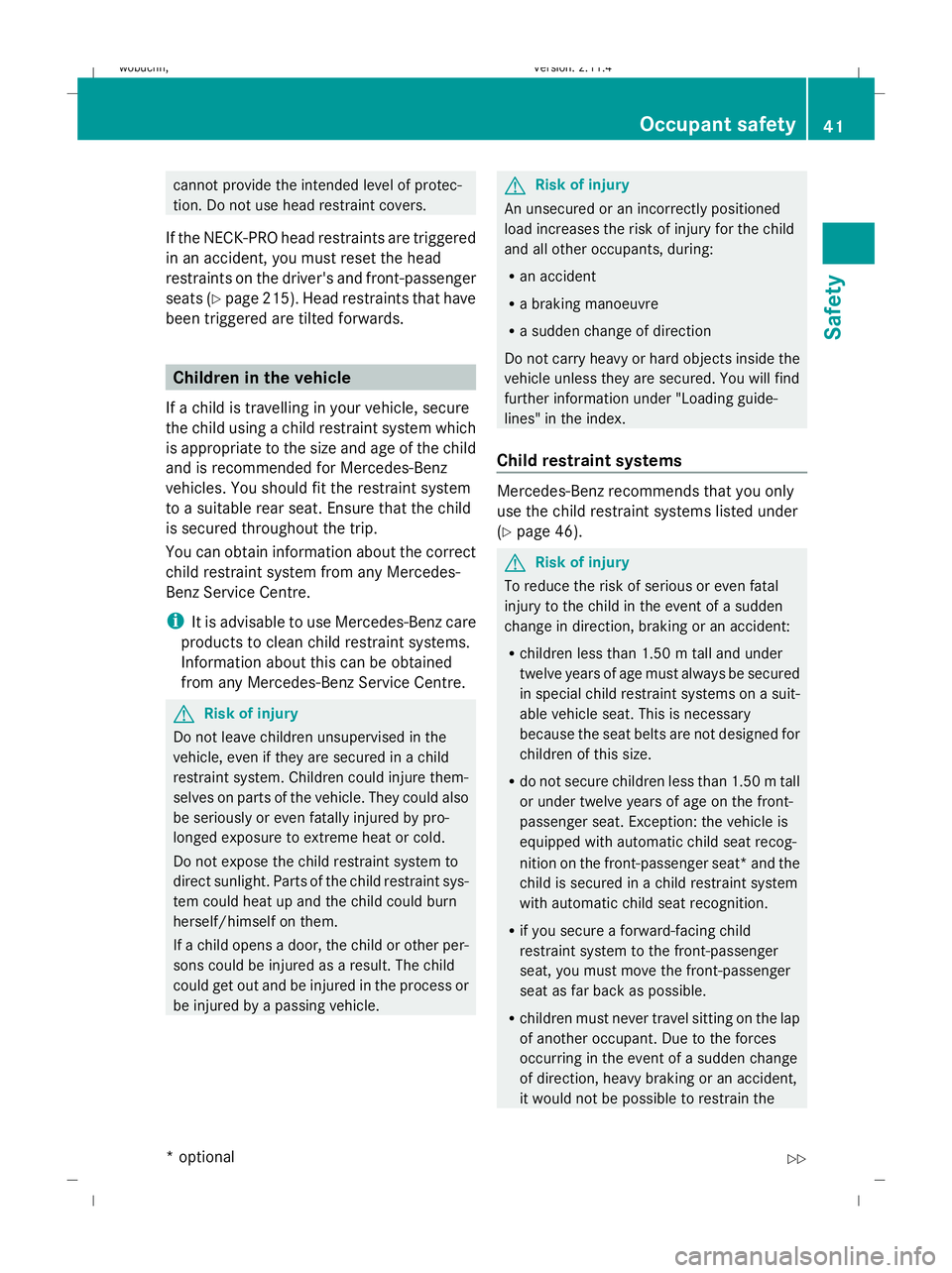
cannot provide the intended level of protec-
tion. Do not use head restraint covers.
If the NECK-PRO head restraints are triggered
in an accident, you must reset the head
restraints on the driver's and front-passenger
seats (Y page 215). Head restraints that have
been triggered are tilted forwards. Children in the vehicle
If a child is travelling in your vehicle, secure
the child using a child restraint system which
is appropriate to the size and age of the child
and is recommended for Mercedes-Benz
vehicles. You should fit the restraint system
to a suitable rear seat. Ensure that the child
is secured throughout the trip.
You can obtain information about the correct
child restraint system from any Mercedes-
Benz Service Centre.
i It is advisable to use Mercedes-Benz care
products to clean child restraint systems.
Information about this can be obtained
from any Mercedes-Benz Service Centre. G
Risk of injury
Do not leave children unsupervised in the
vehicle, even if they are secured in a child
restraint system. Children could injure them-
selves on parts of the vehicle. They could also
be seriously or even fatally injured by pro-
longed exposure to extreme heat or cold.
Do not expose the child restraint system to
direct sunlight. Parts of the child restraint sys-
tem could heat up and the child could burn
herself/himself on them.
If a child opens a door, the child or other per-
sons could be injured as a result. The child
could get out and be injured in the process or
be injured by a passing vehicle. G
Risk of injury
An unsecured or an incorrectly positioned
load increases the risk of injury for the child
and all other occupants, during:
R an accident
R a braking manoeuvre
R a sudden change of direction
Do not carry heavy or hard objects inside the
vehicle unless they are secured. You will find
further information under "Loading guide-
lines" in the index.
Child restraint systems Mercedes-Benz recommends that you only
use the child restraint systems listed under
(Y
page 46). G
Risk of injury
To reduce the risk of serious or even fatal
injury to the child in the event of a sudden
change in direction, braking or an accident:
R children less than 1.50 m tall and under
twelve years of age must always be secured
in special child restraint systems on a suit-
able vehicle seat. This is necessary
because the seat belts are not designed for
children of this size.
R do not secure children less than 1.50 m tall
or under twelve years of age on the front-
passenger seat. Exception: the vehicle is
equipped with automatic child seat recog-
nition on the front-passenger seat* and the
child is secured in a child restraint system
with automatic child seat recognition.
R if you secure a forward-facing child
restraint system to the front-passenger
seat, you must move the front-passenger
seat as far back as possible.
R children must never travel sitting on the lap
of another occupant. Due to the forces
occurring in the event of a sudden change
of direction, heavy braking or an accident,
it would not be possible to restrain the Occupant safety
41Safety
* optional
X204_AKB; 1; 5, en-GB
wobuchh,
Version: 2.11.4 2008-10-15T13:20:56+02:00 - Seite 41 ZDateiname: 6515_0671_02_buchblock.pdf; preflight
Page 45 of 261
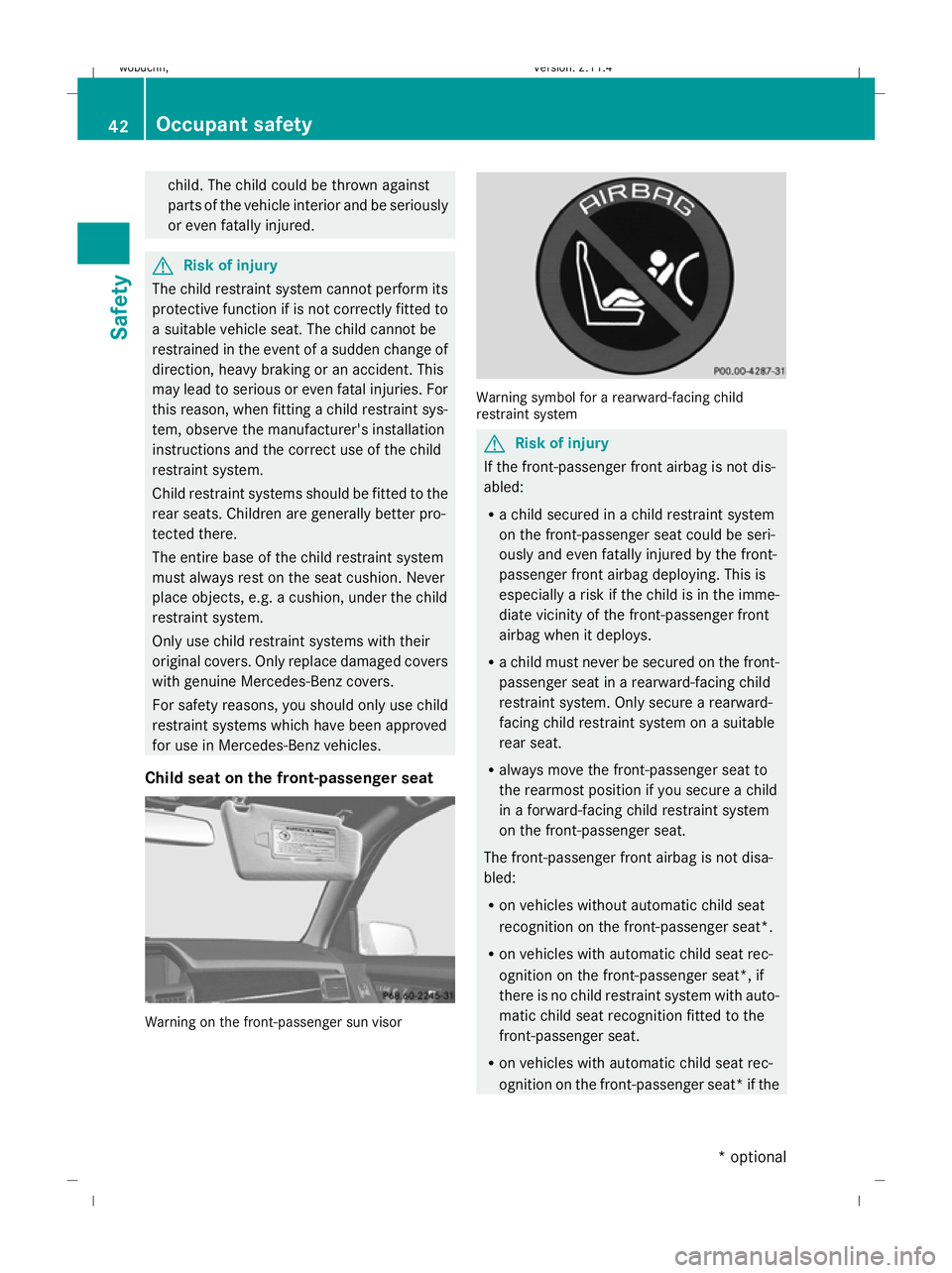
child. The child could be thrown against
parts of the vehicle interior and be seriously
or even fatally injured. G
Risk of injury
The child restraint system cannot perform its
protective function if is not correctly fitted to
a suitable vehicle seat. The child cannot be
restrained in the event of a sudden change of
direction, heavy braking or an accident. This
may lead to serious or even fatal injuries. For
this reason, when fitting a child restraint sys-
tem, observe the manufacturer's installation
instructions and the correct use of the child
restraint system.
Child restraint systems should be fitted to the
rear seats. Children are generally better pro-
tected there.
The entire base of the child restraint system
must always rest on the seat cushion. Never
place objects, e.g. a cushion, under the child
restraint system.
Only use child restraint systems with their
original covers. Only replace damaged covers
with genuine Mercedes-Benz covers.
For safety reasons, you should only use child
restraint systems which have been approved
for use in Mercedes-Benz vehicles.
Child seat on the front-passenger seat Warning on the front-passenger sun visor Warning symbol for a rearward-facing child
restraint system
G
Risk of injury
If the front-passenger front airbag is not dis-
abled:
R a child secured in a child restraint system
on the front-passenger seat could be seri-
ously and even fatally injured by the front-
passenger front airbag deploying. This is
especially a risk if the child is in the imme-
diate vicinity of the front-passenger front
airbag when it deploys.
R a child must never be secured on the front-
passenger seat in a rearward-facing child
restraint system. Only secure a rearward-
facing child restraint system on a suitable
rear seat.
R always move the front-passenger seat to
the rearmost position if you secure a child
in a forward-facing child restraint system
on the front-passenger seat.
The front-passenger front airbag is not disa-
bled:
R on vehicles without automatic child seat
recognition on the front-passenger seat*.
R on vehicles with automatic child seat rec-
ognition on the front-passenger seat*, if
there is no child restraint system with auto-
matic child seat recognition fitted to the
front-passenger seat.
R on vehicles with automatic child seat rec-
ognition on the front-passenger seat* if the 42 Occupant safetySafety
* optional
X204_AKB; 1; 5, en-GB
wobuchh,
Version: 2.11.4 2008-10-15T13:20:56+02:00 - Seite 42Dateiname: 6515_0671_02_buchblock.pdf; preflight
Page 46 of 261
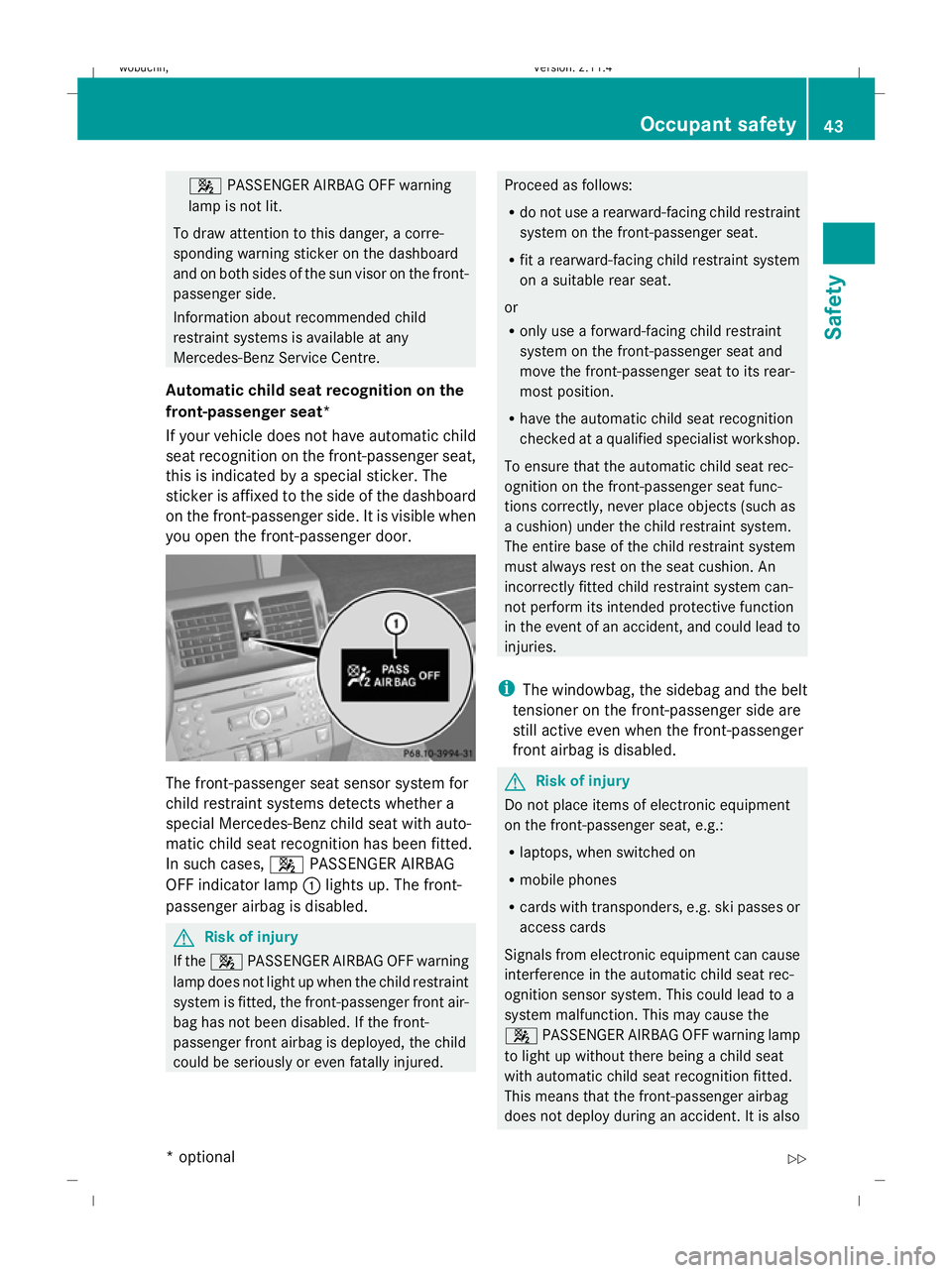
4
PASSENGER AIRBAG OFF warning
lamp is not lit.
To draw attention to this danger, a corre-
sponding warning sticker on the dashboard
and on both sides of the sun visor on the front-
passenger side.
Information about recommended child
restraint systems is available at any
Mercedes-Benz Service Centre.
Automatic child seat recognition on the
front-passenger seat*
If your vehicle does not have automatic child
seat recognition on the front-passenger seat,
this is indicated by a special sticker. The
sticker is affixed to the side of the dashboard
on the front-passenger side. It is visible when
you open the front-passenger door. The front-passenger seat sensor system for
child restraint systems detects whether a
special Mercedes-Benz child seat with auto-
matic child seat recognition has been fitted.
In such cases, 4PASSENGER AIRBAG
OFF indicator lamp :lights up. The front-
passenger airbag is disabled. G
Risk of injury
If the 4 PASSENGER AIRBAG OFF warning
lamp does not light up when the child restraint
system is fitted, the front-passenger front air-
bag has not been disabled. If the front-
passenger front airbag is deployed, the child
could be seriously or even fatally injured. Proceed as follows:
R
do not use a rearward-facing child restraint
system on the front-passenger seat.
R fit a rearward-facing child restraint system
on a suitable rear seat.
or
R only use a forward-facing child restraint
system on the front-passenger seat and
move the front-passenger seat to its rear-
most position.
R have the automatic child seat recognition
checked at a qualified specialist workshop.
To ensure that the automatic child seat rec-
ognition on the front-passenger seat func-
tions correctly, never place objects (such as
a cushion) under the child restraint system.
The entire base of the child restraint system
must always rest on the seat cushion. An
incorrectly fitted child restraint system can-
not perform its intended protective function
in the event of an accident, and could lead to
injuries.
i The windowbag, the sidebag and the belt
tensioner on the front-passenger side are
still active even when the front-passenger
front airbag is disabled. G
Risk of injury
Do not place items of electronic equipment
on the front-passenger seat, e.g.:
R laptops, when switched on
R mobile phones
R cards with transponders, e.g. ski passes or
access cards
Signals from electronic equipment can cause
interference in the automatic child seat rec-
ognition sensor system. This could lead to a
system malfunction. This may cause the
4 PASSENGER AIRBAG OFF warning lamp
to light up without there being a child seat
with automatic child seat recognition fitted.
This means that the front-passenger airbag
does not deploy during an accident. It is also Occupant safety
43Safety
* optional
X204_AKB; 1; 5, en-GB
wobuchh,
Version: 2.11.4 2008-10-15T13:20:56+02:00 - Seite 43 ZDateiname: 6515_0671_02_buchblock.pdf; preflight
Page 47 of 261
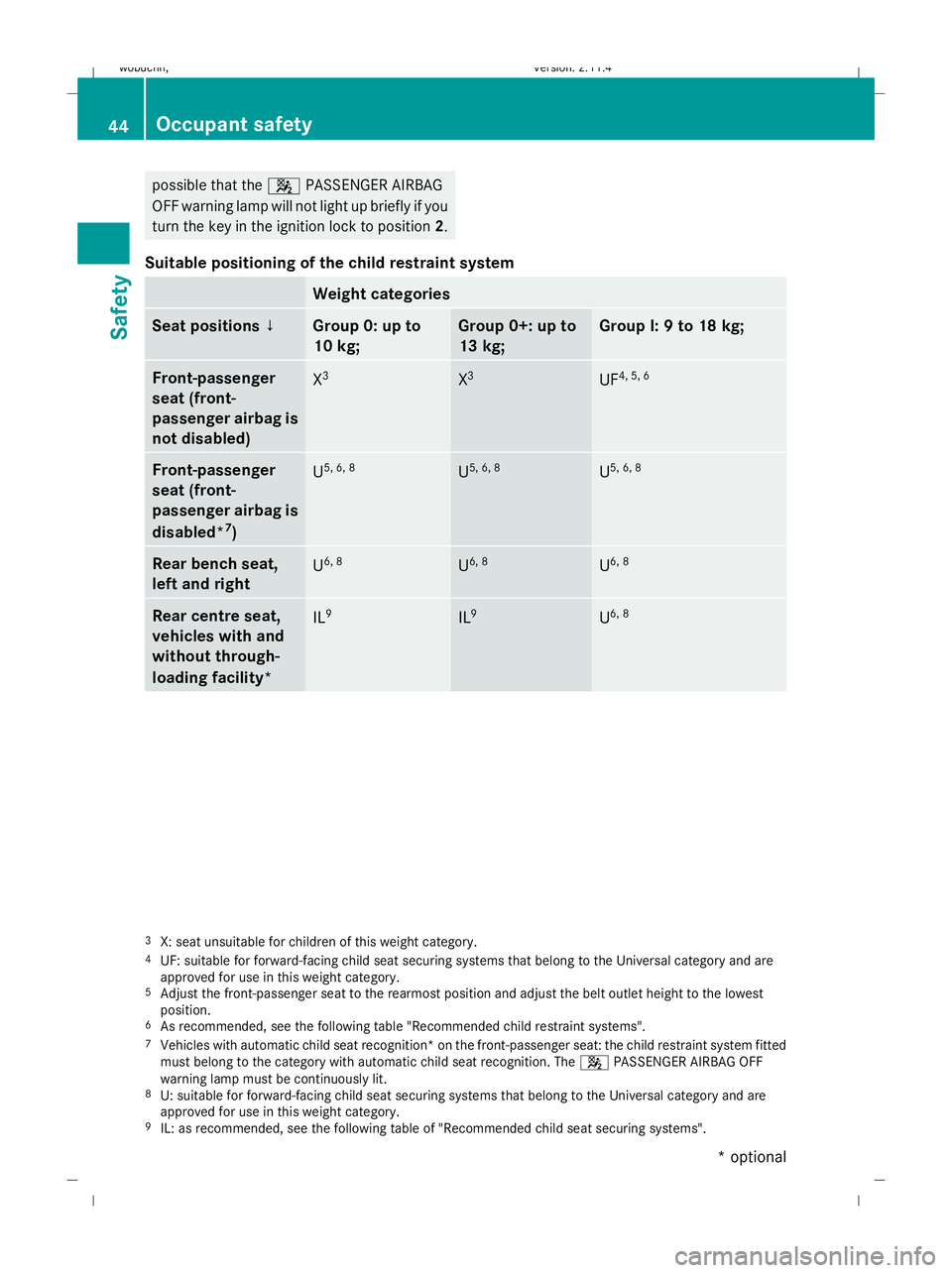
possible that the
4PASSENGER AIRBAG
OFF warning lamp will not light up briefly if you
turn the key in the ignition lock to position 2.
Suitable positioning of the child restraint system Weight categories
Seat positions ↓ Group 0: up to
10 kg; Group 0+: up to
13 kg; Group I: 9 to 18 kg;
Front-passenger
seat (front-
passenger airbag is
not disabled)
X
3 X
3 UF
4, 5, 6 Front-passenger
seat (front-
passenger airbag is
disabled*
7
) U
5, 6, 8 U
5, 6, 8 U
5, 6, 8 Rear bench seat,
left and right
U
6, 8 U
6, 8 U
6, 8 Rear centre seat,
vehicles with and
without through-
loading facility*
IL
9 IL
9 U
6, 8 3
X: seat unsuitable for children of this weight category.
4 UF: suitable for forward-facing child seat securing systems that belong to the Universal category and are
approved for use in this weight category.
5 Adjust the front-passenger seat to the rearmost position and adjust the belt outlet height to the lowest
position.
6 As recommended, see the following table "Recommended child restraint systems".
7 Vehicles with automatic child seat recognition* on the front-passenger seat: the child restraint system fitted
must belong to the category with automatic child seat recognition. The 4PASSENGER AIRBAG OFF
warning lamp must be continuously lit.
8 U: suitable for forward-facing child seat securing systems that belong to the Universal category and are
approved for use in this weight category.
9 IL: as recommended, see the following table of "Recommended child seat securing systems". 44 Occupant safetySafety
* optional
X204_AKB; 1; 5, en-GB
wobuchh,
Version: 2.11.4 2008-10-15T13:20:56+02:00 - Seite 44Dateiname: 6515_0671_02_buchblock.pdf; preflight
Page 48 of 261
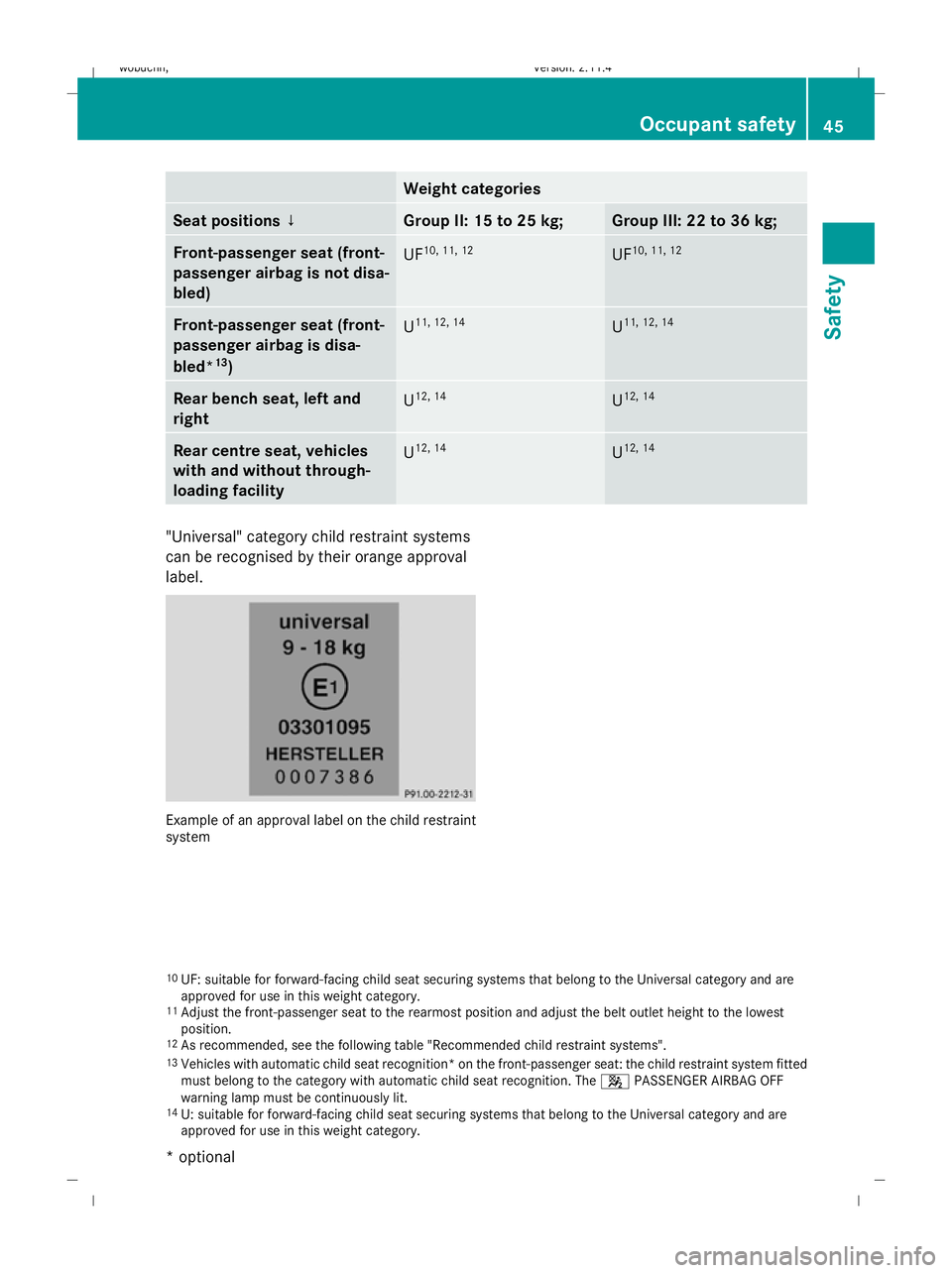
Weight categories
Seat positions ↓ Group II: 15 to 25 kg; Group III: 22 to 36 kg;
Front-passenger seat (front-
passenger airbag is not disa-
bled) UF
10, 11, 12 UF
10, 11, 12 Front-passenger seat (front-
passenger airbag is disa-
bled* 13
) U
11, 12, 14 U
11, 12, 14 Rear bench seat, left and
right U
12, 14 U
12, 14 Rear centre seat, vehicles
with and without through-
loading facility
U
12, 14 U
12, 14 "Universal" category child restraint systems
can be recognised by their orange approval
label. Example of an approval label on the child restraint
system
10 UF: suitable for forward-facing child seat securing systems that belong to the Universal category and are
approved for use in this weight category.
11 Adjust the front-passenger seat to the rearmost position and adjust the belt outlet height to the lowest
position.
12 As recommended, see the following table "Recommended child restraint systems".
13 Vehicles with automatic child seat recognition* on the front-passenger seat: the child restraint system fitted
must belong to the category with automatic child seat recognition. The 4PASSENGER AIRBAG OFF
warning lamp must be continuously lit.
14 U: suitable for forward-facing child seat securing systems that belong to the Universal category and are
approved for use in this weight category. Occupant safety
45Safety
* optional
X204_AKB; 1; 5, en-GB
wobuchh,
Version: 2.11.4 2008-10-15T13:20:56+02:00 - Seite 45 ZDateiname: 6515_0671_02_buchblock.pdf; preflight
Page 49 of 261
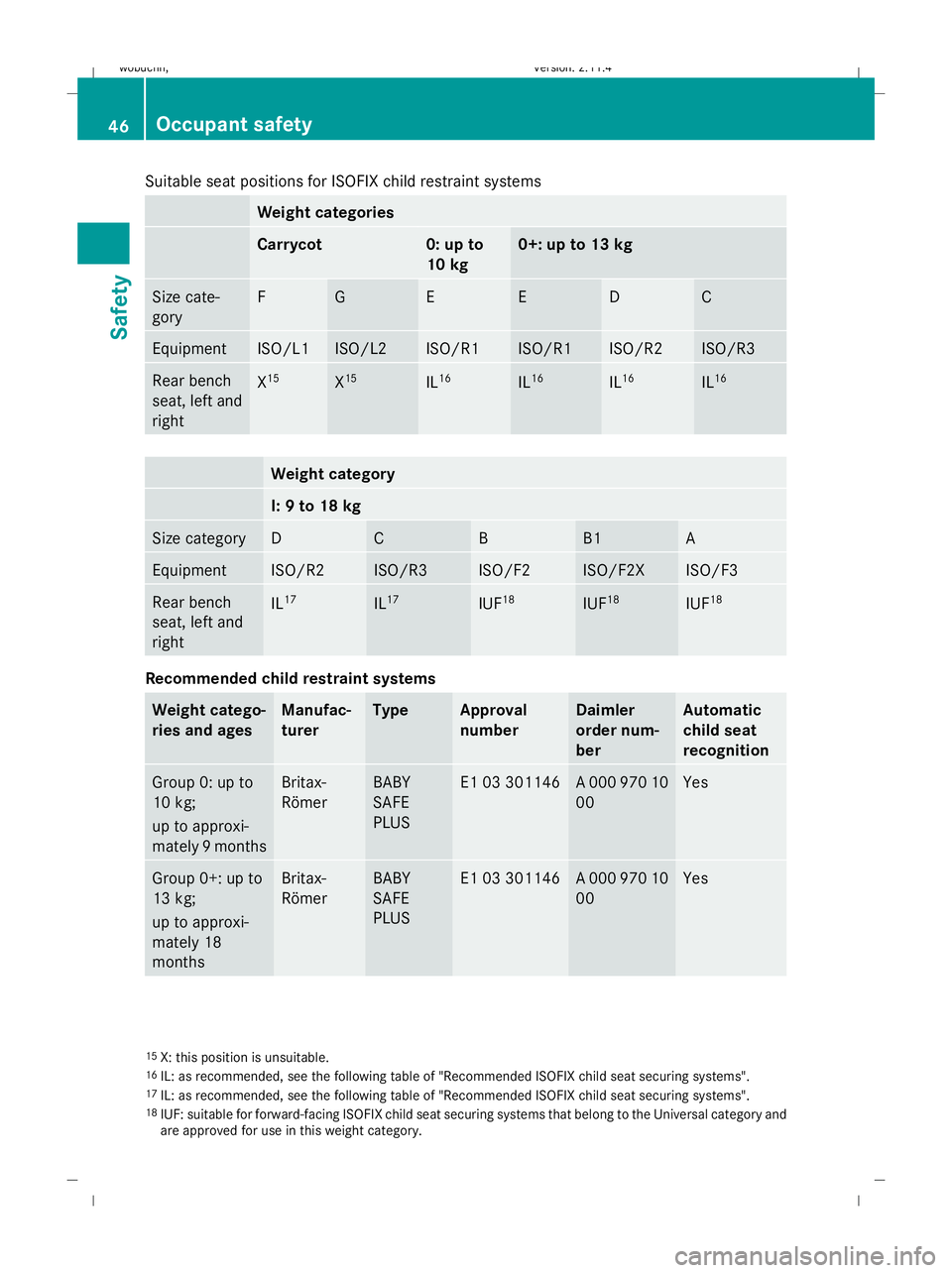
Suitable seat positions for ISOFIX child restraint systems
Weight categories
Carrycot 0: up to
10 kg 0+: up to 13 kg
Size cate-
gory F G E E D C
Equipment ISO/L1 ISO/L2 ISO/R1 ISO/R1 ISO/R2 ISO/R3
Rear bench
seat, left and
right
X
15 X
15 IL
16 IL
16 IL
16 IL
16 Weight category
I: 9 to 18 kg
Size category D C B B1 A
Equipment ISO/R2 ISO/R3 ISO/F2 ISO/F2X ISO/F3
Rear bench
seat, left and
right
IL
17 IL
17 IUF
18 IUF
18 IUF
18 Recommended child restraint systems
Weight catego-
ries and ages Manufac-
turer Type Approval
number Daimler
order num-
ber Automatic
child seat
recognition
Group 0: up to
10 kg;
up to approxi-
mately 9 months Britax-
Römer BABY
SAFE
PLUS E1 03 301146 A 000 970 10
00 Yes
Group 0+: up to
13 kg;
up to approxi-
mately 18
months Britax-
Römer BABY
SAFE
PLUS E1 03 301146 A 000 970 10
00 Yes
15
X: this position is unsuitable.
16 IL: as recommended, see the following table of "Recommended ISOFIX child seat securing systems".
17 IL: as recommended, see the following table of "Recommended ISOFIX child seat securing systems".
18 IUF: suitable for forward-facing ISOFIX child seat securing systems that belong to the Universal category and
are approved for use in this weight category. 46 Occupant safetySafety
X204_AKB; 1; 5, en-GB
wobuchh,
Version: 2.11.4 2008-10-15T13:20:56+02:00 - Seite 46Dateiname: 6515_0671_02_buchblock.pdf; preflight
Page 50 of 261
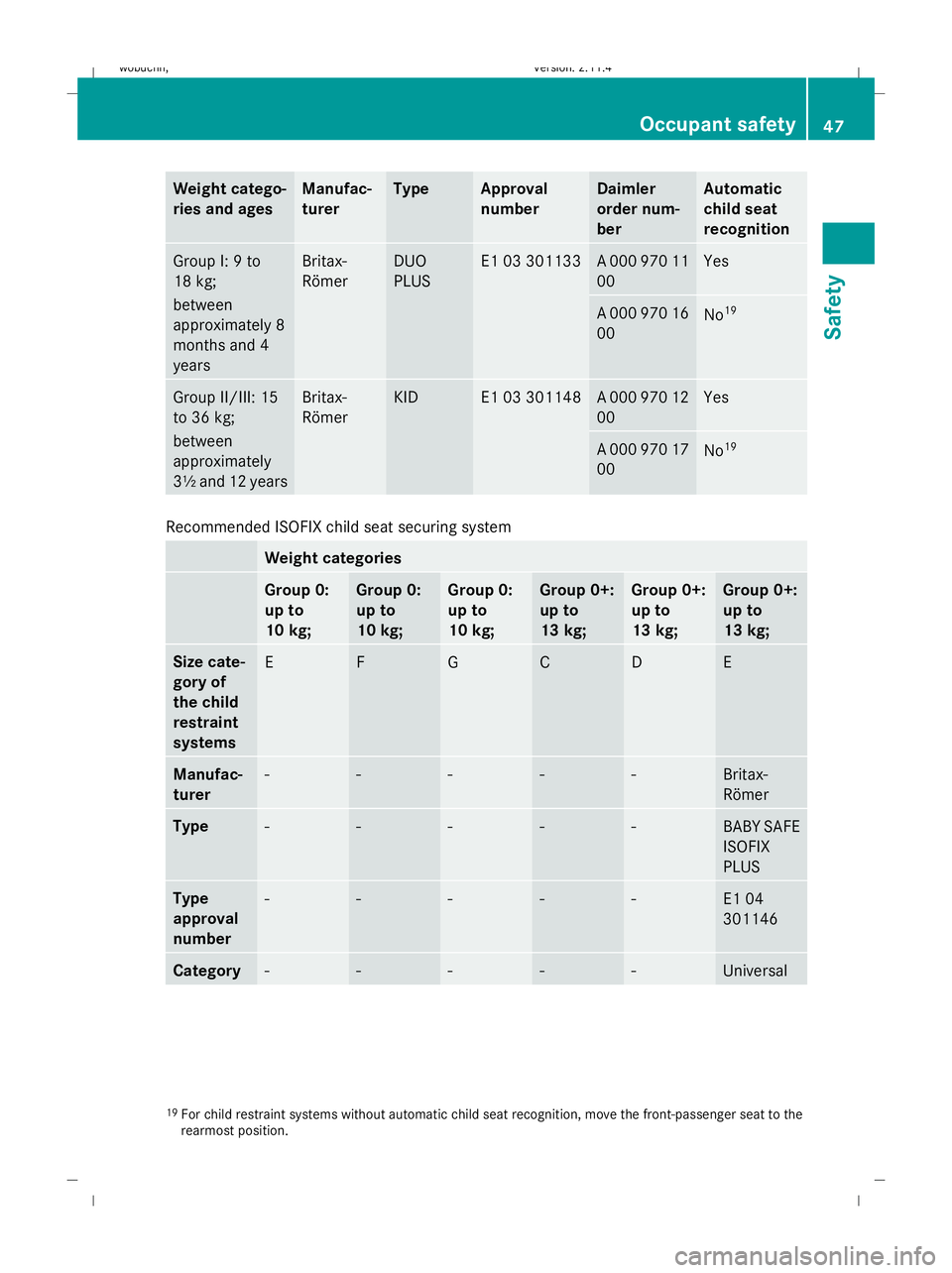
Weight catego-
ries and ages Manufac-
turer Type Approval
number Daimler
order num-
ber Automatic
child seat
recognition
Group I: 9 to
18 kg;
between
approximately 8
months and 4
years Britax-
Römer DUO
PLUS E1 03 301133 A 000 970 11
00 Yes
A 000 970 16
00
No
19 Group II/III: 15
to 36 kg;
between
approximately
3½ and 12 years Britax-
Römer KID E1 03 301148 A 000 970 12
00 Yes
A 000 970 17
00
No
19 Recommended ISOFIX child seat securing system
Weight categories
Group 0:
up to
10 kg; Group 0:
up to
10 kg; Group 0:
up to
10 kg; Group 0+:
up to
13 kg; Group 0+:
up to
13 kg; Group 0+:
up to
13 kg;
Size cate-
gory of
the child
restraint
systems
E F G C D E
Manufac-
turer
- - - - - Britax-
Römer
Type
- - - - - BABY SAFE
ISOFIX
PLUS
Type
approval
number
- - - - - E1 04
301146
Category
- - - - - Universal
19
For child restraint systems without automatic child seat recognition, move the front-passenger seat to the
rearmost position. Occupant safety
47Safety
X204_AKB; 1; 5, en-GB
wobuchh, Version: 2.11.4 2008-10-15T13:20:56+02:00 - Seite 47 ZDateiname: 6515_0671_02_buchblock.pdf; preflight